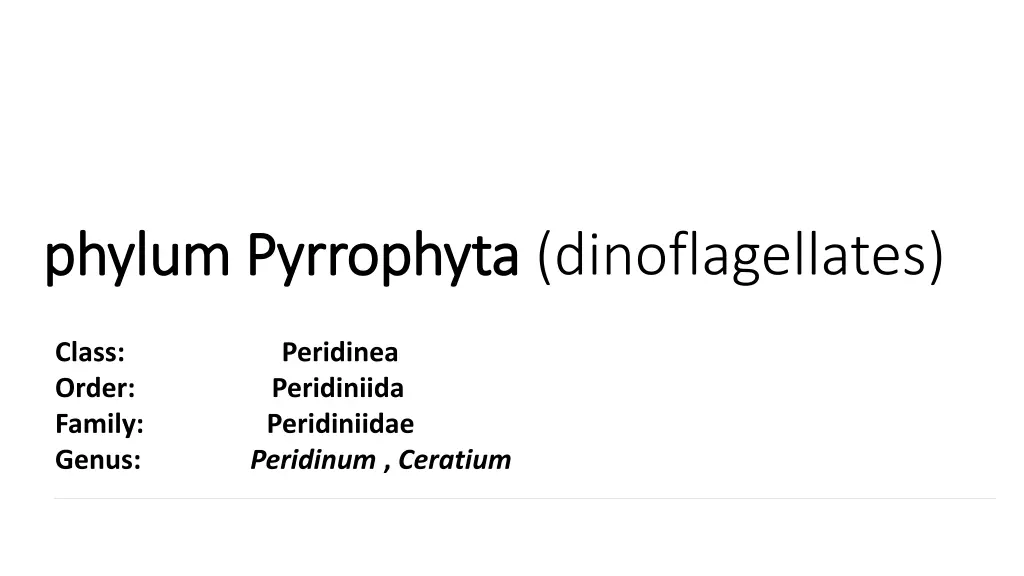
Characteristics of Pyrrophyta and Chrysophyta Algae
Explore the unique characteristics of Pyrrophyta (dinoflagellates) and Chrysophyta (Yellow-green algae) including cell structures, flagella arrangements, pigments, and reproductive methods. Learn about Peridinium, Ceratium, Vaucheria, and more fascinating features of these algal divisions.
Uploaded on | 0 Views
Download Presentation

Please find below an Image/Link to download the presentation.
The content on the website is provided AS IS for your information and personal use only. It may not be sold, licensed, or shared on other websites without obtaining consent from the author. If you encounter any issues during the download, it is possible that the publisher has removed the file from their server.
You are allowed to download the files provided on this website for personal or commercial use, subject to the condition that they are used lawfully. All files are the property of their respective owners.
The content on the website is provided AS IS for your information and personal use only. It may not be sold, licensed, or shared on other websites without obtaining consent from the author.
E N D
Presentation Transcript
phylum phylum Pyrrophyta Pyrrophyta (dinoflagellates) Class: Peridinea Order: Peridiniida Family: Peridiniidae Genus: Peridinum , Ceratium
General characteristics General characteristics They commonly have a cell covering structure named (theca) composed of cellulose or polysaccharide. The theca is laced with spine. unicellular algae that has a yellow brown color has two different flagella which are ribbon-shaped. A longer flagellum lies in a groove called the sulcus, and a shorter flagellum lies perpendicular to the first in a groove called the girdle. The positioning of the flagella causest he cell to swim in a rotating motion. pigments (chlorophyll-a, chlorophyll-b, c1, c2 and fucoxanthin) that can photosynthesize. food is starch and oil.
-algal bodies are composed of upper part (Epicon) and lower part (Hypocon) separated by transverse groove or annulus. In addition, having a longitudinal groove called (sulcus) containing pair of flagella (long and short).
Peridinium Peridinium
Ceratium This alga is similar to the former one except that the epicon contains a fork like structures called ( dorsal horn) and the hypocon contains double fork called (ventral horn).
Division: Division: chrysophyta chrysophyta (Yellow (Yellow- -green) green) 1- Class: xanthophyceae Family : Vaucheriaceae. Genus: Vaucheria
General characteristics of chrysophyta: Yellow-green algae Pigments: Chlorophyll a, e, carotene and xanthophylls Eukaryotic unicellular to simple filamentous the main Food Type Stock leucosin and oil droplets. -Reproduction: Vegetative, Asexual and Sexual (Mainly Isogamous, Anisogamy is rare, Oogamous in Vaucheria)
vaucheria vaucheria fialmens cylindrical form,irregular branded This genus is characterized by lacking cross walls called (coenocytic) except in association with reproductive organs. reproduce sexually by Oogamous reproduction. There are two characterized species in Vaucheria: a- Vaucheria sessils: in this species reproductive organs are setting directly on algal body. b- Vaucheria geminata: in this species reproductive organs are stalked on a small holder.
